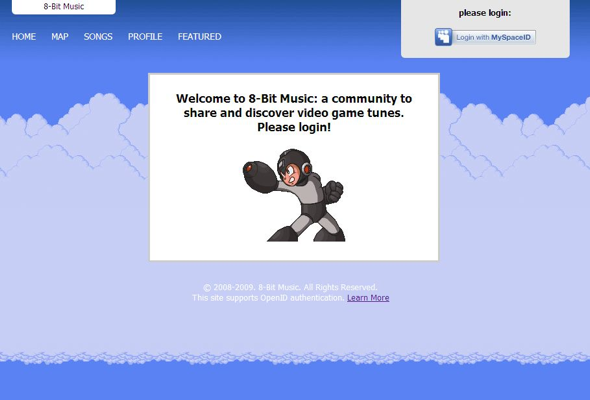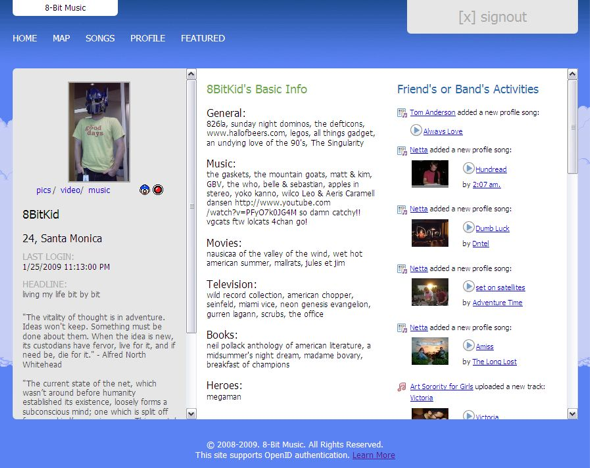 MySpace is trying to make it easier for other sites to access its user data — and eventually features like streaming music playlists. The service, called MySpaceID, is partway through being rolled out, and we got a sneak peak at some new features yesterday at the DEMO conference in Palm Springs. MySpaceID product lead Max Engel showed off these slides, above and below, illustrating a simple process for signing into another site using your MySpace username and password, and accessing information about you and your friends on that site — including a new way to see your activity streams from MySpace on other sites.
MySpace is trying to make it easier for other sites to access its user data — and eventually features like streaming music playlists. The service, called MySpaceID, is partway through being rolled out, and we got a sneak peak at some new features yesterday at the DEMO conference in Palm Springs. MySpaceID product lead Max Engel showed off these slides, above and below, illustrating a simple process for signing into another site using your MySpace username and password, and accessing information about you and your friends on that site — including a new way to see your activity streams from MySpace on other sites.
The social network isn’t saying when the latest features will go live, but it’s looking pretty close to ready. And the sooner the better.
Readers who use Facebook will no doubt notice the similarity of the MySpaceID sign-in page to Facebook’s similarly-intentioned service, Connect. That’s not the only comparison one makes between the two companies. Given Facebook’s rapid growth around the world — more than 175 million monthly active users today and gaining 5 million new ones a week — MySpace is looking a little beleaguered. It has a slow-growing base of 130 million monthly active users, albeit with 76 million of those in the relatively lucrative U.S. market. Worse, the social network’s chief operating officer Amit Kapur and two of its top technology and product leaders are leaving to start their own company (MySpace has confirmed the news with us, after it leaked out yesterday). MySpace must innovate in ways that neither Facebook nor other social networking rivals can, and we don’t know if if it has a full team to help it do so.
Which is why MySpaceID increasingly matters. MySpace itself has a couple assets that rivals don’t. One is music: MySpace Music is a joint venture between the company and major record labels, that gives it the right to let its users do things like create and stream playlists. Only a couple other companies, like Imeem, have similar rights. Facebook wants to — given its interest in creating a music service — but as far as we know that project has not been moving forward since last year. MySpace’s streaming video service, while much smaller than YouTube’s, is larger than everyone else’s. The combination of music, video and a social network continues to make MySpace a great place for entertainers to launch new albums or videos and attract fans. MySpaceID is a potentially big way to take advantage of all of this.
Essentially, it could provide licensed, lawsuit-free music and videos to other sites around the web, tied together with its social network. This is something Facebook is not currently in a position to do. MySpace has already focused on making money through ads, including new ways for anyone to buy their own ads on the site, and ways to target ads based on detailed information about its users. In a leaked memo about Kapur’s departure, MySpace chief executive Chris DeWolfe says as much: “We are effectively monetizing the stickiest sections of our site such as Music and Video by coupling the world’s richest content offering with creative ad programming online and off.”
Perhaps we will see MySpace roll out a web-wide advertising service that goes along with MySpaceID, that allows advertisers to reach other sites. This could create new revenue streams not just for MySpace, but for its content partners and for third-party sites. The combination of MySpace user data, content and advertising also goes hand-in-hand with other services. In the memo, DeWolfe also says that aside from developments in MySpaceID and its developer platform; the company also has major launches planned for a payments system and virtual goods. MySpace Music, meanwhile, will role out features like hit charts, ticketing and merchandise. As Engel tells me:
I think that you’ll see more interesting MySpaceID implementations as brands look to provide cohesion between their presence on-site through profiles and off-site with MySpaceID. This kind of full-circle stickiness for brands has definitely resonated as we engage with partners about MySpaceID. For example, a band can reach their community on-site and use MySpaceID as a bridge when [the user] travels to the band’s microsite.
All of this also ties in with the company’s mobile strategy. In a wide-ranging interview with VentureBeat last month, MySpace mobile executive John Faith discussed the company’s plans to get its social data and content — and ads — on every mobile device. He sees half of MySpace’s users accessing the site through mobile devices in the near future. One day, MySpace could provide services like mobile streaming playlists, concert ticket purchases, and much more, from any device anywhere.
The key will be execution. The departure of product leaders is a bad sign — although Facebook and other rivals have seen similar attrition in the last couple of years. One key, as TechCrunch notes, is for MySpace to be given full leeway to go after these opportunities within parent company News Corp.’s organizational structure. Rumors have circulated that MySpace cofounders DeWolfe and Tom Anderson (now the company’s president) may leave later this year — they should stick around. The company has lost the lead in users to Facebook, and at least buzz to overlapping services like microblogging service Twitter. MySpace is hardly dead, but the clock is ticking.
[Update: Nick Gonzalez from Social Media has a closer look at existing MySpaceID features here.]



